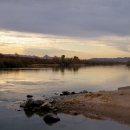Visit Us
National wildlife refuges offer us all a chance to unplug from the stresses of daily life and reconnect with our natural surroundings. Bill Williams River National Wildlife Refuge offers visitors an opportunity to view a wide array of wildlife species in a beautiful desert setting. The wide open waters of Lake Havasu are home to waterfowl in the winter, the jagged cliffs that form the river canyon are a walk in the park to a desert bighorn sheep, and the migrating forest birds cannot resist the opportunity to refuel in the forested areas of the river’s floodplain. If it is fishing that you seek you won’t be disappointed by the world class opportunities that bring anglers from across the country. Whether you see the refuge from the water or land you will not forget your visit to Bill Williams River National Wildlife Refuge.
Driving Directions
To get to the Visitor Center:
From Lake Havasu City, Arizona, follow Arizona Highway 95 south approximately 17 miles. The entry road to the visitor center and associated trails and fishing docks is on the right-hand side of the road (34.291554, -114.104776) at mile marker 161.
From Parker, AZ follow Arizona Highway 95 north approximately 16 miles. Refuge Headquarters/ Visitor Center will be on the left-hand side of the road.
Fees
There is no charge to visit.
Restrooms
Restrooms are available inside the refuge visitor center, with vault toilets at the trail head of the Peninsula Trail and near the fishing docks.
Points Of Interest
The visitor center provides brochures and site maps with information about the refuge and the locations of visitor amenities such as the Peninsula and Delta hiking trails, auto tour route, fishing docks, and the non-motorized boat launch.
What To Do
If you have 15-minutes.
- Read the interpretive signs at the trailhead.
- View the tortoise enclosure and have a chance encounter with our resident desert tortoise.
- View desert pupfish in the pupfish pond.
- Observe wildlife such as waterfowl on the lake or birds in the shrubbery.
- Enjoy the interpretive displays in the visitor center.
If you have one hour.
- Drive the auto tour route and view the post fire restoration efforts on the Bill Williams River floodplain.
- Hike the Peninsula or Delta trails.
If you have half a day or more.
- Kayak the Bill Williams River channel.
- Fish from the three fishing docks.
Know Before You Go
Spring, fall, and winter are the best times to visit the refuge and enjoy mild temperatures. Be sure to bring plenty of drinking water even in the winter. Wear appropriate clothing and time your outings according to weather conditions. Keep an eye out for rattlesnakes which are not abundant but are occasionally seen on the refuge.
Visitor Tips
Morning and evening times are when wildlife are most active and most likely to be seen. The refuge receives the most visitation on weekends but there is seldom a day when solitude cannot be found.
Activities
The Bill Williams River National Wildlife Refuge offers activities that meet the interests of most user groups from wildlife observation and photography to fishing and hunting.
Trails
Peninsula Trail
- Open Season: All year
- Length: 0.5 miles each way (1 mile round trip)
- Location of trail: Headquarters
- Surface: The first 0.25 miles is paved and ADA compliant; the last 0.25 miles is dirt which will not meet the needs of wheel chair transportation.
- Difficulty: Low
- Information: The Peninsula Trail begins near the visitor center and leads guests down a stretch of land that was reclaimed from the construction of the Central Arizona Project pumping station and features native plants, interpretive panels, restrooms, solar powered lights, cabanas, benches, and three fishing piers. This trail offers the opportunity to see a some migratory song birds in spring and fall and waterfowl in winter.
Delta Loop Trail
- Open Season: All year
- Length: 0.5 miles
- Location of trail: Headquarters
- Surface: Gravel
- Difficulty: Moderate
- Information: The Delta Loop Trail is a spur off of the Peninsula Trail near the first cabana and leads guests through a planting of mesquite trees past the non-motorized boat ramp and onto a ridge that overlooks the delta marsh habitat of the Bill Williams River. This is a good place to look for migrating birds in the spring and fall and it offers great views of waterfowl in winter.
Other Facilities in the Complex
Rules and Policies
There are a lot of fun, interesting, and educational things you can do on the refuge. Keep in mind, if an activity is not wildlife related and doesn't help in the protection or understanding of wildlife or their habitat, there are probably refuge rules governing this activity. Please check with refuge management before participating in an activity that could harm the environment or yourself. There are plenty of activities at Bill Williams River National Refuge for you to enjoy. Be safe and have fun!
Locations













Restrooms are available inside the refuge visitor center, with vault toilets at the trail head of the Peninsula Trail and near the fishing docks.
To get to the Visitor Center:
From Lake Havasu City, Arizona, follow Arizona Highway 95 south approximately 17 miles. The entry road to the visitor center and associated trails and fishing docks is on the right-hand side of the road (34.291554, -114.104776) at mile marker 161.
From Parker, Arizona follow Arizona Highway 95 north approximately 16 miles. Refuge Headquarters/Visitor Center will be on the left-hand side of the road.
If using google maps to find the refuge search for "Bill Williams River National Wildlife Refuge Visitor Center" as your keyword. Other search phrases lead to a remote dirt road on the refuge with no facilities.


